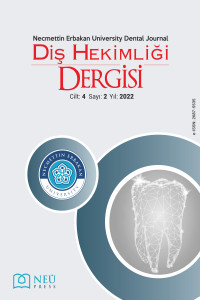Subpontik Osseöz Hiperplazi: Bir Retrospektif Çalışma
Amaç: Subpontik osseöz hiperplazi (SOH), alveolar kemiğin sabit protetik restorasyonların pontik kısmının altında kalan alveoler kemiğin iyi huylu kemik proliferasyonu olarak adlandırılır. Tespit edildiği ilk yıllarda literatürde sadece mandibula posteriorda görüldüğü belirtilse de son yıllarda maksilla posteriorda da bulunduğu belirtilmiştir. Bu çalışmanın amacı SOH’ un yaş ve cinsiyete göre toplumdaki görülme sıklığının incelenmesidir. Gereç ve Yöntemler: Bu çalışma NEÜ Diş Hekimliği Fakültesi Ağız, Diş ve Çene Radyolojisi Kliniğine Ocak 2020 ve Ağustos 2022 tarihleri arasında başvuran 40 yaş ve üzeri, rastgele seçilen, anamnez bilgileri eksiksiz olarak TurcaSoft uygulaması üzerinden çekilmiş olan 500 hastanın panoramik radyografi kayıtlarının retrospektif olarak incelenmesiyle gerçekleştirilmiştir Bulgular: İncelenen 500 hastanın panoramik radyografları neticesinde SOH görülme oranı %6,4’tür. Elde edilen sonuçlara göre; cinsiyete göre subpontik varlığı bakımından istatistiksel olarak anlamlı bir farklılık bulunmaktadır (p<0,05). Erkeklerin %7,6’sında, kadınların ise %4,1’inde SOH bulgusuna rastlanmıştır. Erkeklerde kadınlara göre daha yüksek oranda SOH bulgusuna rastlanmıştır. Yaş grupları incelediğinde; katılımcıların %34,6’sı 40-49 yaş grubunda iken, %43,2’si 50-59 yaş arasında, %19,6’sı 60-69 yaş arasında ve %2,6’sı 70 yaş üzerindedir. Elde edilen sonuçlara göre; en yüksek oranda SOH varlığı 70 yaş üzeri bireylerde (30,8%) olup 70 yaş üzeri bireylerin SOH varlığı diğer yaş gruplarına göre anlamlı şekilde farklılaşmaktadır. Katılımcıların %65,8’i erkek, %34,2’si kadındır. Sonuç: Sabit bölümlü protez kullanan hastalarda pontik altında fonksiyonel streslerin birikimiyle ya da kronik iritasyon gibi etkenlerin sebep olduğu kortikal kemiğin proliferasyonu ile sonuçlanan SOH ‘nin herhangi bir biyopsi ya da cerrahi tedaviye gereksinimi olmadığı bilinmelidir. Protetik restorasyon üzerindeki kuvvet dağılımları optimum okluzyon kriterlerine uygun olarak tasarlanmalıdır ayrıca prematür kontaklar ve interferensler gibi hataların eliminasyonu da oldukça önemlidir.
Anahtar Kelimeler:
Osseöz hiperplazi, Sabit bölümlü protez, Pontik
Subpontic Osseous Hyperplasia: A Retrospective Study
Aim: Subpontic osseous hyperplasia (SOH) is referred to as benign bony proliferation of alveolar bone under the pontic part of fixed partial denture of alveolar bone. The purpose of this study is to examine the prevalence of SOH in the society in terms of age and gender.Material and Methods: This study was carried out by retrospectively examining the panoramic radiographs of approximately 500 patients who applied to x Faculty of Dentistry Oral, Dental and Maxillofacial Radiology Clinic between January 2020 and August 2022, randomly selected over 40 years of age, with complete anamnesis information obtained from the TurcaSoft application.Results: As a result of panoramic radiographs of 500 patients examined, the incidence of SOH was found to be 6.4%. SOH findings were found at a higher rate in men than in women. According to the determined results; the highest rate of SOH is in individuals over 70 years of age (30.8%), and the presence of SOH in individuals over 70 years of age differs significantly from other age groups.Conclusion: It should be known that SOH, which results in the proliferation of cortical bone caused by the accumulation of dysfunctional stresses under the pontic or by factors such as chronic irritation, in patients using fixed partial dentures, does not require any biopsy or surgical treatment. The force distributions on the prosthetic restoration should be designed in accordance with the optimum occlusion criteria, and the elimination of errors such as premature contacts and interferences is also very important.
Keywords:
Osseöz hiperplazi, Sabit bölümlü protez, Pontik,
___
- 1. Armitage GCJAop. Development of a classification system for periodontal diseases and conditions. 1999;4(1):1-6.
- 2. Takeda Y, Itagaki M, Ishibashi KJJoP. Bilateral subpontic osseous hyperplasia: a case report. 1988;59(5):311-4.
- 3. Wasson DJ, Rapley JW, Cronin RJJTJopd. Subpontic osseous hyperplasia: a literature review. 1991;66(5):638-41.
- 4. Burkes Jr EJ, Marbry DL, Brooks REJTJopd. Subpontic osseous proliferation. 1985;53(6):780-5.
- 5. Aydin U, Yildirim D, Bozdemir EJEjod. Subpontic osseous hyperplasia: Three case reports and literature review. 2013;7(03):363-7.
- 6. Morton Jr TH, Natkin EJTJoPD. Hyperostosis and fixed partial denture pontics: report of 16 patients and review of literature. 1990;64(5):539-47.
- 7. Daniels WCJJoP. Subpontic osseous hyperplasia: a five‐patient report. 1997;6(2):137-43.
- 8. Lorenzana ER, Hallmon WWJQI. Subpontic osseous hyperplasia: a case report. 2000;31(1).
- 9. Kessler HP, Phillips DJTDJ. Oral and maxillofacial pathology case of the month. Bilateral supbontic osseous hyperplasia. 2006;123(12):1153, 6-9.
- 10. Cailleteau JGJJoE. Subpontic hyperostosis. 1996;22(3):147-9.
- 11. Islam MN, Cohen DM, Waite MT, Bhattacharyya IJQI. Three cases of subpontic osseous hyperplasia of the mandible: a report. 2010;41(4).
- 12. Lee CA, Lee MB, Matthews CR, Takakis DJGD. Subpontic osseous hyperplasia: a case series and literature review. 2014;62(4):46-52.
- Yayın Aralığı: Yılda 3 Sayı
- Başlangıç: 2019
- Yayıncı: Necmettin Erbakan Üniversitesi
Sayıdaki Diğer Makaleler
Subpontik Osseöz Hiperplazi: Bir Retrospektif Çalışma
İbrahim Burak YÜKSEL, Neslihan GÜNTEKİN, Ali ALTINDAĞ, Ali Riza TUNCDEMİR
Nuran YANIKOĞLU, Özcan AKKAL, Gülsüm AKKAYA
Zeynep TAŞTAN EROĞLU, Dilek ÖZKAN ŞEN, Fatma UCAN YARKAC, Fatma SARAÇ
Pulpal-Periapikal Patolojiler ile Hemofili Arasındaki İlişkinin İncelenmesi
Yasemin Derya FİDANCIOĞLU, Hazal ÖZER, Ayşe ŞİMŞEK, Hüseyin TOKGÖZ
Diş Hekimliği Fakültesine Başvuran Hastaların Dental İmplant Farkındalıkların Değerlendirilmesi
Dilek ÖZKAN ŞEN, Fatma UCAN YARKAC, Zeynep TAŞTAN EROĞLU, Hilal Gülcan SEYFİOĞLU
